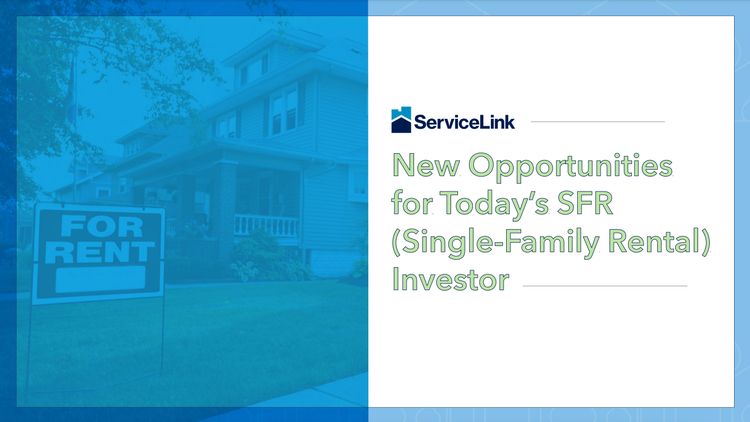Long before the onset of the pandemic in 2020, pundits were debating whether the U.S. was becoming a nation of renters. Evidence under consideration included the 12-year decline in the homeownership rate following its historic peak of 69.2% in 2004, and a steadily declining rental vacancy rate. Homeownership did gain momentum again, from 2016 to early 2020, when it reached 67.9%, but by year-end 2021, it stood at 65.5%, with the rental vacancy rate at 5.6%, its lowest point since 1984.
Two important trends are reflected in these figures: (1) Growing numbers of Americans are in fact choosing to rent versus buy, and (2) there simply are not enough rental properties available to meet this growing demand. Both of these trends offer real estate investors new opportunities to diversify their portfolios, particularly in the single-family rental space, which has become the largest segment of the rental market by valuation (over $4 trillion) and households served, according to Freddie Mac.
“The SFR market has become a hot investment opportunity, as people are seeking the homeowner experience without the long-term commitment it typically requires,” says Amy Borsi Daniel, senior vice president, Title & Close, ServiceLink. “SFR properties appeal to a variety of people: those who are saving to buy a home, young professionals wanting to move closer to family and friends now that remote work is a possibility, families that lack a down payment, empty nesters, etc. Investors are playing a critical role in making high-quality SFR housing options available to them.”
Market conditions play a role in who’s investing
For their part, investors are evaluating a variety of factors before entering, or increasing their participation in, the SFR market. According to Joseph Ticchione, vice president, Financial Planning and Analysis, ServiceLink, investors are keeping a close watch on the rate of appreciation of real estate, as well as interest rates and government regulations that stand as potential barriers to entry.
“Investors have mixed feelings about what’s next for property values. Are we looking at a housing bubble, where prices are on the brink of decline, or should we look for appreciation to just level off or slow down a bit? We know that rising interest rates are causing some smaller investors to pause, which has opened the door for larger investors — often cash buyers — to buy SFR properties in a much less competitive environment,” says Ticchione.
On the regulatory side, a recent HUD ruling is affecting large and small investors alike. “ML 2022-08 adds an initial 30-day exclusive sales period for CWCOT post-foreclosure sales for owner-occupants, HUD-approved nonprofits and governmental entities. This is preventing investors from bidding on 35 to 45% of the properties coming into the marketplace for at least the first 30 days,” Ticchione explains.
Despite these potential deterrents, investors are enthusiastic about the potential of SFR properties. Consumer demand shows no signs of letting up, and forward-thinking investors are stepping up to fill the need.
Build-to-rent segment bolsters the housing supply
One of the most exciting areas of SFR investment is the build-to-rent segment. As demand for rental homes outpaces supply, investors are teaming up with construction companies to build communities of rental homes that may provide residents with amenities such as playgrounds, dog parks, fitness centers, walking trails and pools.
“With more than $85 billion now slated for BTR projects, this SFR opportunity opens up a whole new area of consideration for investors. They can have the product built the way they want it and fulfill consumers’ desire to live in a house in a neighborhood without the constraints of homeownership,” says Daniel.
Adds Lorraine Perez, assistant vice president of Single-Family Rental Services, ServiceLink, “BTR became part of the rental housing solution when investors began to realize they could address the shortage of homes by building an entire neighborhood rather than investing in one-off properties in multiple neighborhoods. For them, BTR communities offer a steady income stream from brand-new homes that require minimal attention and repairs. Add to that the prospect of appreciation over time, and it’s hard to see where investors lose with this type of investment.”
Vacation rentals offer a unique opportunity
Travel trends have been unpredictable the past few years, as the pandemic, high gas prices and airline challenges have all made impacts. Still, Americans spent $101 billion on travel spending in May 2022, signaling a rebound that reminds investors of the income potential of vacation rental homes.
“Typically, vacation homes generate returns of 10 to 20% over time, so if investors can hold onto them through low moments, even if they have to reduce the rental charge temporarily, I think they’ll come out stronger on the other side,” says Perez. “People are taking big vacations again.”
Daniel adds that, in addition to investors buying vacation homes to rent themselves, some larger companies are purchasing luxury homes in places like Napa and Scottsdale and selling shares of the homes to create viable investment opportunities for small, individual investors. “As opposed to a timeshare, this is a time ownership, where people buy one-sixth or one-eighth of a home,” she explains. “They own their share of the house, so if they want out of the investment at any time, they can sell whatever portion of the home they purchased.”
Factors to consider as you add to your SFR portfolio
At the risk of sounding cliché, the most popular real estate quote of all time — “location, location, location” — rings true for the SFR market. “You can always change the asset; you can never change the location,” says Daniel. “Investors need to become familiar with the rental market in the area they are considering. Is it still affordable for people to purchase homes there, based on the median income? What level of demand exists for rental homes? How long have available rental homes in the area been on the market?”
The other major factor to consider is, of course, the potential financial return. “The rent you charge needs to not only cover fixed and variable costs — maintenance, taxes, mortgage, unexpected repairs, etc. — but also provide you with a return,” Daniel says. “Think through all of the considerations related to cost. For example, are you going to cover water, sewage and trash? Who will manage the property? Who will take the calls at 1 a.m. when there’s an emergency? Who will collect the rent and serve your notices? As an investor, you need to factor in every possible scenario to protect your ROI.”
Adds Perez, “Once you’ve looked at the location and all of the costs involved, you have to consider what you can afford to risk as markets fluctuate. What level of loss can you afford to take? How much financial backing do you have to carry this home if you’re not renting it? If you would not be able to afford to maintain that house during a slump in the market, then you’re not ready to get in.”
Hot markets or high yields? Where the action is
Of the 43 million renter households in the U.S., 35.5 million are in urban and suburban markets; 7.5 million in rural markets, says Freddie Mac. SFR homes represent about 58%, or 25 million, of those renter households, and the top five MSAs for SFRS, by count, are New York, Los Angeles, Chicago, Philadelphia and Dallas. The top five MSAs with the largest number of SFRs in rural designated areas are Riverside, California; Dallas; Atlanta; Nashville; and Columbus, Ohio.
The SFR market is much, much broader than this list, of course, with emerging hotspots lighting up across the country. Successful investors know that getting the geography right has a lot to do with how successful particular investments may be, and each one of them looks at locations a bit differently. Some are of the mindset that diving into hot markets is their best bet for long-term success, while others seek investment opportunities in more affordable markets, where they estimate greater potential for higher returns.
“Investing in SFR properties is a lot like investing in the stock market: When everything’s going up, everyone invests in stocks and hopes for the best. When we’re worried the market’s going to go down, there’s a retreat to dividend-yielding stocks; the equivalent is investing in places where properties offer the greatest yield over their direct costs,” says Ticchione. “I’ve seen a correlation between more affordable housing markets — Detroit, Cleveland, Birmingham, Pittsburgh and some of the medium-sized cities in the Carolinas, for example — and greater yields. So, in the near term, while there’s some ambiguity of whether or not we’ll see home appreciation, these markets may offer investors a safer alternative to some of the traditionally hot SFR markets — Phoenix, Salt Lake City, Atlanta, Nashville, etc. — where the cost to acquire and maintain properties can be higher relative to those rents.”
It pays to research the supply and demand, demographics, property availability and affordability, and other characteristics of a location before jumping into SFR investment there. Areas of high job creation and inbound migration are likely to be strong markets, for example, but will those properties provide high enough yields to reach ROI goals? Investors need to make that decision for themselves, keeping in mind their risk tolerance and time horizon.
How technology drives workflow efficiencies
Having the right technology to back their efforts can make all the difference to investors in the SFR space. ServiceLink provides a variety of tools and services, including eClosing and remote online notarization services, which can be critical to an investor buying properties in various regions across the country.
“We give the SFR investor visibility into their transactions so they can follow them from start to finish,” says Perez. “When the time comes to close, we send them all the required documents and offer virtual signings, traditional closings and everything in between to streamline the process however it makes the most sense for them. Our eClosing capabilities enable them to close from their office, home or on the road. Importantly for BTR investors, we offer rolling closing capabilities that ensure they can close on homes quickly as they are completed.”
Daniel points out the importance of human support as well. “ServiceLink assigns a dedicated team to support a particular investor’s goals. We support them through every transaction no matter where in the country they are purchasing properties. That’s a big win for investors, because when you’re closing deals scattered across states or counties, working with a different office for every deal is not time well spent. We know where the investor wants to go and help them get there.”
Finding the right real estate management services partner
Maintaining properties is another critical piece of a successful SFR strategy. Having a reliable national field services partner to orchestrate landscaping, maintenance, rehab and other essential services can help investors avoid violations and costly repairs, and keep properties in tiptop shape for renters.
“ServiceLink Field Services Vendor Management builds close partnerships with local and regional service providers through our own dedicated market managers and directors so we can ensure investors’ properties are well-maintained and protected,” explains Perez. “This partnership approach enables us to mobilize boots on the ground for both day-to-day and emergency services that meet our exceptionally high standards for customer service.”


